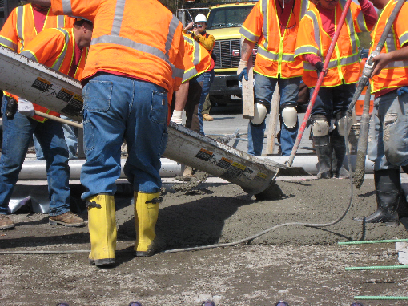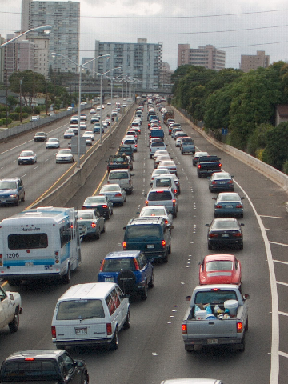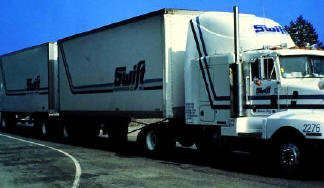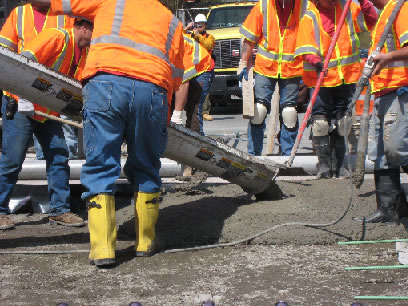To most people, money spent on our nation’s roadways has very direct importance. These roads are the way we get to work, take our kids to school, and often how we see our friends and family, especially during the holiday season. However, in addition to the direct personal benefits that we all derive from a quality roadway network, it’s important to remember just how far-reaching the impacts of road construction on our economy are. In this edition of the RoadReady Newsletter, we’re going to take a look at just how far our dollars go when we invest them into our transportation system. In particular, let’s explore the importance of highway investment to employment, passenger congestion, and our freight network.
 Road construction is a source of job growth
Road construction is a source of job growth
Employment
Jobs created by roadway investment can be put into three major categories. These are direct employment, indirect employment, and induced employment. Direct employment includes workers such as construction laborers, engineers, planners and managers that are involved in the actual construction and maintenance activities. These activities also create employment in supporting industries, including those which provide raw materials such as aggregate, asphalt and Portland cement, or equipment manufacturers. This is known as indirect employment. Finally, the influx in capital to both of the above groups supports the local economies of these individuals, promoting job growth in these communities. This is known as induced employment.
But how many jobs?
The FHWA periodically investigates the employment benefits of federal investment in highway infrastructure. In 2007, the FHWA estimated that an investment of $1 billion in Federal-Aid highways supports the creation of 27,800 jobs. These figures are not static, and tend to change over time as the price of construction materials and wages fluctuate. The FHWA is in the process of updating this number, which will likely be lower in the current economic climate.
 Road congestion is an expensive business
Road congestion is an expensive business
Congestion
The Texas Transportation Institute estimates that in 2010, roadway congestion in 439 urban centers cost Americans $101 billion. This includes both wasted fuel and productivity that are lost sitting in traffic. This is up from $79 billion in 2000. Investment in highways can relieve congestion by creating additional roadway capacity as well as improving the roadways that serve the existing capacity. Deteriorated roadways increase the likelihood of accidents, which can create major delays even where sufficient capacity exists.
Investing in Congestion
The FHWA estimates that for every dollar of government funding on roadways, the public saves 11 cents in congestion costs. This means a typical $5 million improvement project will save drivers around $550,000 in lost wages and fuel over its lifetime. In states with urban areas experiencing high levels of congestion, this figure increases to 19 cents. While these numbers may seem low, keep in mind that they include projects which are not focused on congestion relief.
Spending money to reduce congestion can be difficult, as the areas with the worst congestion generally have little space for capacity expansion. In general, roadway pricing projects such as tolling provide a better return, and are often more feasible in densely constructed areas. These projects encourage drivers to use less congested routes, and improve the efficiency of existing roadway networks. Each dollar spent on these projects relieves 60 cents worth of congestion (for more information on roadway tolling, check out our newsletter archives for our tolling newsletter).
 Road-based freight is essential to the movement of goods throughout the world
Road-based freight is essential to the movement of goods throughout the world
Freight
The roadway-based freight industry has huge importance to the economy. Though they ride 18-wheelers instead of sleighs, truckers are an everyday Santa Claus, constantly delivering not just presents, but the goods that keep the world functioning. This includes close to $10 trillion dollars of goods every year in the U.S. alone, representing 92.5% of the goods by value in 2005. This translates to 72.8% of total tonnage moved, and 61.7% of total ton-miles. In each category, rail-based freight is a distant second. The number of miles traveled by trucks each year continues to increase. Because they use the same freeways, trucks face the same issues as passenger cars regarding degraded roadways and congestion.
Delays to freight have significant economic costs. The FHWA uses a value of $32.15 per hour to estimate the economic impact of freight delay, and this value is seen as conservative. It is estimated that about 40% of truck delays occur at bottlenecks, areas of high freight throughput that experience frequent congestion and backups. This can either occur from high levels of freight traffic, or when truck routes intersect with high levels of passenger traffic. It is estimated that these bottlenecks cost $7.8 billion every year.
Because roadway-based freight promises to remain a dominant component of how we move goods across the country and the world, investment in our highways is critical to reducing these delays and keeping our economy moving. Ton-miles of goods moved by freight are closely correlated with changes in GDP. As a result, maintenance and improvement of highways is critical for economic growth. Benefits of an improved freight network can be grouped into three categories:
- 1st order benefits include the direct savings to shippers and suppliers from reduced truck delay.
- 2nd order benefits are derived from 1st order benefits and include effects such as the capacity for increased production.
- Finally, 3rd order benefits include improved products and innovation as a result of liberated capital.
A significant number of freight bottlenecks occur at highway interchanges, and this has been identified as a target for improvement. Investment in these systems could have serious and immediate benefits for our freight networks.
The Gift That Gives Back
In tough economic times globally, highway infrastructure remains a solid option for investment. Funding our roadways creates jobs, saves precious time for the public, and improves our ability to move goods. Each of these impacts have tangible economic benefits, and help governments get back on the road to recovery.


Thanks a bunch for taking the time to describe the terminlogy for the newbies!